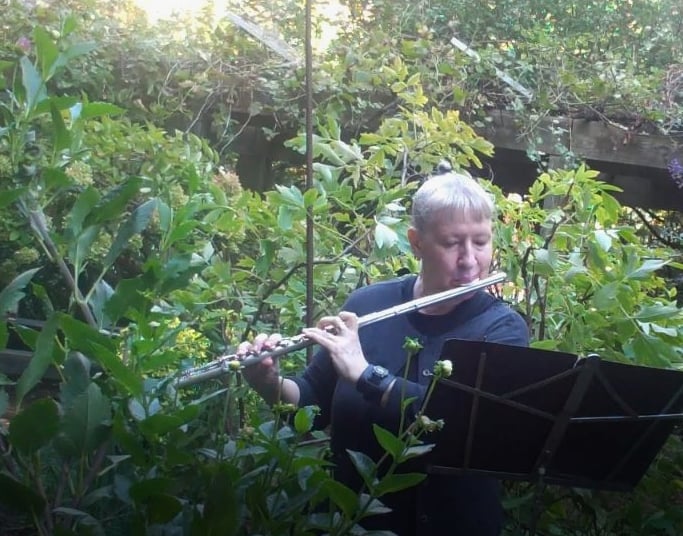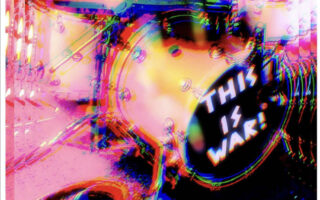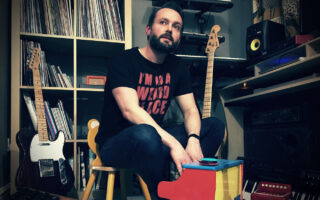
Cheryl Pyle is a jazz flutist who has been playing on the world’s stages for decades. She has played with many of the jazz luminaries and continues to be a dedicated and prolific artist. We decided it was high time for a Cheryl Pyle interview. Here, Cheryl offers an insight into her musical life and some good advice for those who wish to follow her lead.
SS- Sammy Stein
CP- Cheryl Pyle
SS- Tell us briefly about your journey in music so far.
CP – I started playing flute in 1972 after high school. I was attending San Diego Mesa College and was very interested in art studies. I had a music theory teacher, Mr. Henniger, who had studied with Nadia Boulanger. He was so inspiring, that I decided to become a music major. I had some great teachers there and I practiced a lot every day. I had a teacher for private lessons, and one friend played Miles Davis’s ‘Bitches Brew’ and Freddie Hubbard’s ‘Red Clay’ for me. That’s when I decided to play jazz. I worked hard on a lot of classical pieces and in 1974 was accepted into U.C. Berkeley, I auditioned for the music dept. with a Bach Sonata and a Hindemith Sonata. It was a traditional department, so I got a good background in a lot of interesting music, from Olly Wilson’s jazz history class to playing in a gamelan orchestra. I joined the UC Jazz ensembles, with Dr David Tucker conducting the big band, and since many of the sax players did not double on flute, I got to play all the flute parts. Every year, we played at the Pacific Coast Jazz Festival and the big band played one year with all the CTI cats. Freddie Hubbard, Hubert Laws, and Sonny Rollins played with us. Also at that time, I was working in San Francisco, waitressing at the musical Beach Blanket Babylon, and a half block away was Keystone Korner. I was there every night on my break hearing all the jazz greats, from Earl Fatha Hines, Rahsaan Roland Kirk, Horace Silver, Old and New Dreams, A.I. R. Cecil Taylor, Art Ensemble of Chicago, and so many other great bands.
After getting my B.A. in music I decided to move to New York City to play jazz and moved east in 1980. The city at that time was full of jazz and so many clubs and every night I was out listening, meeting musicians, and playing. My first quartet gig was at the Jazz Forum down in Soho at Mark Morganelli’s loft club. I played with Fred Hersch, Ron McClure, and Billy Hart. It was jazz heaven to play with so many great musicians and I had a lot to learn.
I continued throughout the years playing with as many people as I could to learn more and get experience improvising. Many times, I was the only woman, but I did not stop trying, and many times I had to arrange my concerts, and groups, and do everything myself, but I learned a lot about how to book concerts, how to get publishing for compositions, how to get a distributor for CDs, etc. I have been in NYC ever since, working part-time jobs and playing jazz. It’s been a wonderful journey in music and now at almost 70, I continue to record and play around my neighborhood. I have always loved the classical pieces for flute, and work on a lot of new flute music, as well as migrating from straight-ahead playing to more free improvisation as I got older. I started my own record company in 1996 to document my composing and leave a her-story. I still play in 2024 with my Beyond Flute Group which I started with Bern Nix in 2013 and the all-women Musique Libre Femmes group.
SS: Your list of recordings is impressive. Are you releasing music in the near future?
CP: I have my record label, so in the spirit of Sun Ra I release many mp3 CDs from live concerts and also record online with a free jazz Trio. We just recorded ‘ART JAZZ’ on the 11th Street music label, ‘Beyond Flute Trio LIVE’ and ‘Beyond Flute Group Live at Downtown Music Gallery.’ Before the internet, I was able to record in the RCA /BMG studio live with some of my jazz idols – Tom Harrell, Joe Lovano, Danilo Perez, Charlie Haden, and Paul Motian. Many of my jazz singer friends have also recorded some of my lyrics – Janis Siegel, Roseann Vitro, Sheila Jordan, Gloria Cooper, Jeri Brown, and others.
SS: What inspires you?
CP: Music is a never-ending learning experience. It’s like a spiral, upward. You learn something, but then there is always more to learn, ever upward and always inspiring, challenging, and fulfilling.
SS: How did you find musicians to work with?
CP: Before the internet, we all used to go to each other’s gigs, talk and set up sessions, play each other’s tunes, etc. In those days, I would call musicians and ask them to play a gig with me. Things are very different now and a lot of meetings happen through platforms like Facebook but there are many wonderful groups to play with. During COVID, many of us recorded online from home, sending tracks and files to each other during the pandemic shutdown in NYC.
SS: How is it promoting your music? Do you target specific audiences, or put it out and hope for the best?
CP: Mostly I am trying to document our concerts for her-story and targeting any specific audience. many times, we play free improvisation at local gardens or libraries and the audience may be new to this style, but people seem to enjoy it and the birds especially love the flute.
SS: As a female artist, do you feel there is any prejudice or expectations of women that male performers do not have or do you feel the field is even now?
CP: When I started playing, I never saw women on the bandstands. It seems more open now, but I have had my ‘ME TOO’ moments as late as 2019. I still see mostly all-male groups, and the established jazz players are mostly men. I still feel that women’s roles in our society still get in the way of creativity, and being taken seriously, or considered a true artist is still gated by the media and mostly left for the guys. I always try to persevere and not let that stop me from playing the music I love to play.
SS: If you were to advise a young performer just starting out, are there any lessons you might pass on?
CP: Practice daily, save composed fragments and ideas, and try to play in as many bands as possible. If you like a group or musician, reach out for a lesson, and stay open.
SS: Looking ahead – what would you like to have achieved in say, five- or ten years’ time music-wise?
CP: At 70, I hope to continue playing music. I still practice every day and finally have all the flutes, piccolo, C flute, alto flute, and bass flute. There is always a lot to learn. I love playing around my neighborhood and play the local gardens every summer and the local library and free jazz galleries and venues. retirement is full of music.
SS: What would you say are the hardest areas of being a musician?
CP: When I had to work the day jobs and play at night, it was exhausting. I feel happy to now be retired and just playing music.
SS: Is it difficult to fit music in with other aspects of your life?
CP: I always found time after day jobs for music. It was the best part of the day for me and ever if was tired, I practiced.
SS: Have you found the impact of streaming on making a living from your music to have had any impact?
CP: I never was able to make money playing jazz. That is the music business, but not music. I always had a regular job and played what I wanted to play and continued despite any traditional ways to stay with music. This seemed crazy to most, but it worked for me. I found it was the best way to stay creative and love the music. Online recording and posting music have been great for connecting with musicians from all over the world since about 2008 or 20099, and I have recorded CDs with musicians in Germany, Norway, Sweden, Italy, Indonesia, and Russia. etc. It’s been a great way to connect, but not great for the traditional record companies who held the keys to the recording kingdoms. Now we can all record and this has made it an interesting time with groups on Bandcamp, etc.
Beyond Flute Trio | Cheryl Pyie, Michael Eaton, Gene Coleman | Cheryl Pyle (bandcamp.com)
Factory Streams: Live Vids for Covid: Cheryl Pyle and the Beyond Flute Group | The Fuse Factory



